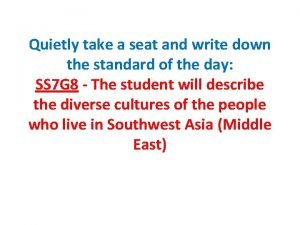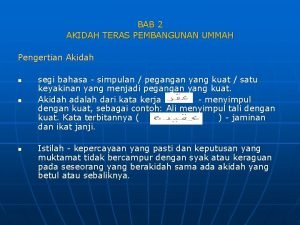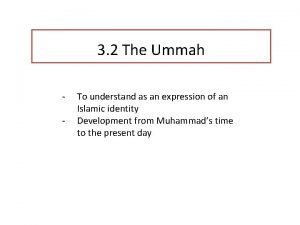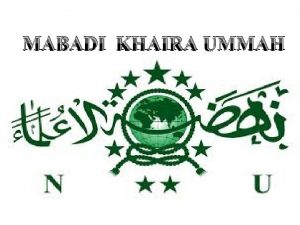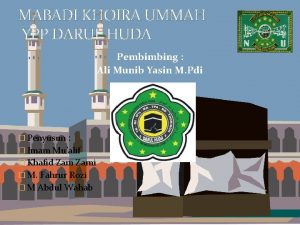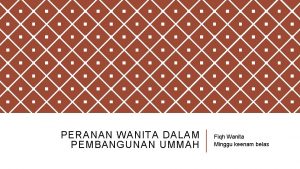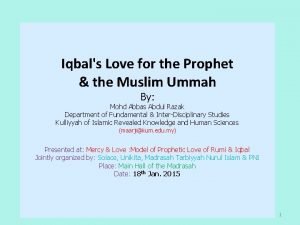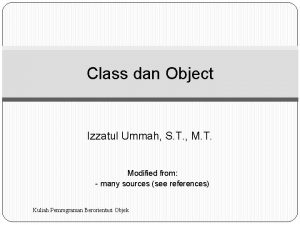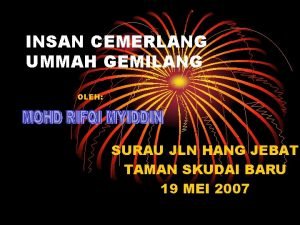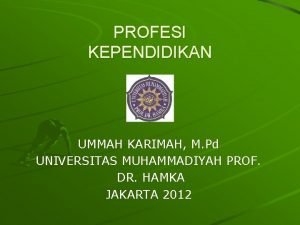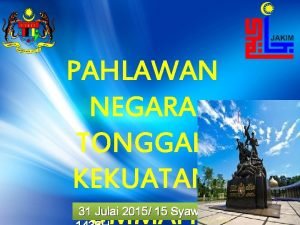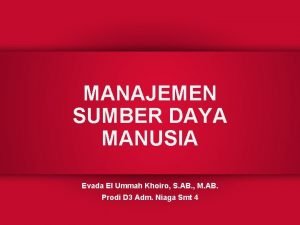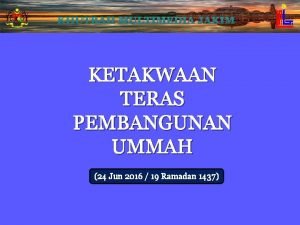3 2 The Ummah To understand as an














- Slides: 14

3. 2 The Ummah To understand as an expression of an Islamic identity Development from Muhammad’s time to the present day

What does Ummah mean? The Arabic word Ummah is some times translated as nation, or the worldwide one and united community with common beliefs and practices.

What does the Qur’an say? • The believers are but a single brother hood/sisterhood (Qur'an s 49: v 10). • The term Ummah is mentioned in the Qur’an 62 times • The nature of the bond of Iman (faith) which unites the members of the Muslim Ummah and protects them against disunity. • ‘The Muslim is the brother to every other Muslim. ’ (hadith)

What changed? • Before the conception of the Ummah, Arab communities were typically governed by kinship. • The political ideology of the Arabs centred around tribal affiliations and blood relational ties. • Earlier messengers who had been sent to various communities in the past. • Muhammad had been given the task to develop a Universal Ummah. His purpose as messenger was to transmit the divine message The Qur’an and lead the Islamic community to salvation. • God is directing the life affairs of the Ummah. • The purpose of the Ummah was to be based on religion, following the commands of God, rather than kinship.

On whiteboard How the concept of Ummah is interpreted within in the 5 pillars of Islam? Shahadah Salah Zakah Sawm Hajj

The concept of Ummah within 5 pillars • Shahadah: Islam was the religion of Medina and a Theocracy established. The first pillar of Islam, Tawhid, Shahadah Declaration of faith represent unity; same words for every Muslim. • The obligatory articles of worship are conducted in together / in congregation: • Salah: Congregational daily prayers have the reward of 27 individual prayers, as is clear from the say ing of the Prophet Muhammad. Jumu’a and Eid prayers have to be performed in congregation. • Zakah was established to help widows, orphans and poor worldwide. • Sawm (Fasting) is a group action by the community for the month of Ramadan, as pre scribed by Allah. • Hajj (Pilgrimage) is a group action by Muslims from all over the world, at a pre scribed time, in a prescribed place, to perform a set of prescribed rituals.

Muslim Ummah Identity • Muhammad, the best role model with perfect religion “The Seal of the Prophets”. • The prayer direction (qiblah) towards Makkah changed from Jerusalem to have a distinctive identity. • The Qur’ān describes this new religious community as “justly balanced community”. • The two annual Muslim religious festivals – Eid al-Fiṭr and Eid al-Aḍḥā – mentioned in the ḥadīth. Every community has its own religious festivals.

Ummah Further reforms in Medina • Polygamy was encouraged , an opportunity to remarry the widows , Muhammad made several marriages which cemented relationship with Muhajirun and Ansaar. • Inheritance rules were revealed • Riba, alcohol and gambling were banned • By 628 CE Muhammad established a truly united theocracy in Medina. • Hijra Calendar begins 622 CE.

Development of The Ummah • Prophet Muhammad passed away in 632 CE • For Sunnis first four caliph are the ‘rightly guided’ (rashidun). They were the founders of the Islamic Empire: 1. Abu. Bakr (632 634 CE) 2. Umar (634 644 CE) 3. Uthman (644 656 CE) 4. Ali (656 – 661 CE) Problem within Ummah: • Shiites disagree with this order of succession, claiming that Ali the son in law and cousin of Muhammad deserved to be the successor.

Evaluation: The (divided) Ummah in present days • The Sunnis- literally means “traditionalist”. They think of themselves as the guardians of Islamic orthodoxy and tradition. • The Shi’a a rupture in Islam, began over political dispute of leadership of Islam (from death of Husayn, grandson of Muhammad, 680 CE). • The source and authority is ‘The Qu’ran and the Hadith’. • Shi’a say leader of Islam is through descendence from Muhammad and also theological differences came. Sufis the mystics, some of whom have been killed/martyred by orthodox Muslims.

Main differences • Sunni • Shia

The Spread of Islam through the History After the death of the Prophet, the Ummah gathered momentum and moved outside Arabia: • Within a century of the Prophet’s death, Muslim armies conquered Palestine, Syria, Persia, Egypt, and swept across North Africa west and into Spain (711 C. E)

What is the role and purpose of Ummah?

Task Plan for a long essay Evaluate the development of Ummah through the history of the world till today. [30 marks]
 How does document e explain how islam spread so quickly
How does document e explain how islam spread so quickly Conclusion of jammu and kashmir
Conclusion of jammu and kashmir Pengertian teras
Pengertian teras 3 2 1 ummah song
3 2 1 ummah song To understand recursion you must understand recursion
To understand recursion you must understand recursion Cách giải mật thư tọa độ
Cách giải mật thư tọa độ Các châu lục và đại dương trên thế giới
Các châu lục và đại dương trên thế giới Bổ thể
Bổ thể Tư thế ngồi viết
Tư thế ngồi viết Giọng cùng tên là
Giọng cùng tên là Thẻ vin
Thẻ vin Thể thơ truyền thống
Thể thơ truyền thống Alleluia hat len nguoi oi
Alleluia hat len nguoi oi Khi nào hổ con có thể sống độc lập
Khi nào hổ con có thể sống độc lập Từ ngữ thể hiện lòng nhân hậu
Từ ngữ thể hiện lòng nhân hậu
